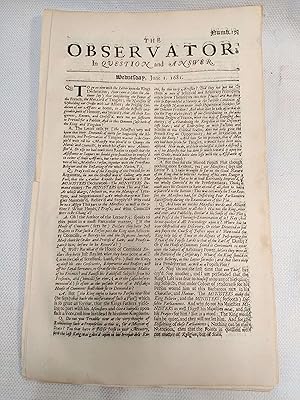About this Item
"Printed for H. Brome at the Gun in S. Pauls Church-yard", 14 one page issues, various numbers from Numb. 7 - 193, April 1681 - April 17, 1686: 1681 - April 27, June 1, June 4, June 18, November 9, November 30, December 31; December 21, 1682; November 26 and December 27, 1684. 1686: February 8, April 14, April 17, July 21. In very good condition. Quarto pages. Sir Roger L'Estrange (1616â_x0080__x0093_1704) was an English pamphleteer, author, courtier, and press censor. L'Estrange used his newspaper The Observator to harangue his opponents and act as a voice for a popular provincial Toryism during the 'Tory Reaction' of 1681-85. In 1681 L'Estrange founded The Observator, a single sheet printed in double columns on both sides. It was written in the form of a dialogue between a Whig and a Tory (later Trimmer and Observator), with the bias on the side of the latter. The Observator was published for 6 years: Vols. 1-3, Ap. 13, 1681- Mr. 9, 1687. During the six years of its existence, L'Estrange wrote with a consistent fierceness, meeting his enemies with personal attacks characterised by sharp wit. One of his main targets was Titus Oates, whose false allegations eventually brought about his conviction for perjury in 1685.The Observator was no longer a mouthpiece for the Court, but represented a provincial Toryism appealing to staunch former Cavaliers like L'Estrange who felt embittered by the Court's pandering to Oates, equivocation towards Whigs, and failure to reward their loyalty. After years dedicated to suppressing the press, L'Estrange aimed at a mass audience. He maintained an educational and paternalistic stance, arguing the paper was necessary to 'set the masses right' after seditious printings had turned them against their natural superiors. The dialogue format lent itself to being read aloud in public spaces, while the aggressive diatribes amused an audience who above all revelled in the drama and vitriol of Restoration politics. As a reward for his propaganda L'Estrange was granted a warrant to seize seditious books or pamphlets in 1662, and was charged with the prevention of the publication of dissenting writings, and authorised to search the premises of printers and booksellers on the merest suspicion of dissension. L'Estrange excelled at this, hunting down hidden presses and enlisting peace officers and soldiers to suppress their activities. He came to be known as the "Bloodhound of the Press." L'Estrange states the purpose of the Observator in Vol. I, No. I, as follows: "My business is, to encounter the Faction, and to vindicate the Government; to detect their Forgeries; to lay open the Rankness of their Calumnies, and Malice; to Refute their Seditious Doctrines; to expose their Hypocrisy, and the bloudy Design that is carry'd on,under the Name, and Semblance, of Religion; And, in short, to liftup the Cloke of the True Protestant (as he Christens himself) and to shew the People, the Jesuite that lies skulking under it." Seller Inventory # 311394
Contact seller
Report this item
![]()

